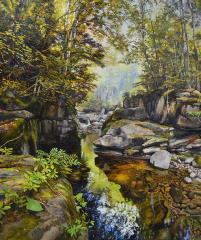Joel Babb: To the Green Woods and Crystal Waters
- Date: July 11, 2019
- Time: 05:00 PM - 07:00 PM
- Location: Greenhut Galleries, Portland

July 5 - August 3
Opening Reception
Thursday, July 11th from 5-7pm
Artist Talk, Saturday, July 20th at 1pm
In July, Greenhut is proud to present Joel Babb's To the Green Woods and Crystal Waters. Joel has been very busy of late, and not only with the creation of work for this exhibition! Earlier this year, he was one of three 1969 alumni chosen to exhibit work and participate in a panel at Princeton's Lewis Arts Complex. His work is also included in Bates College Museum of Art's current exhibition, Uncovered, Selected Works From the Collection. In the fall of 2018, Joel had a solo exhibition and presented a well-attended talk at Bowdoin College. And also in the fall of 2018, the Boston Museum of Fine Art's acquisition of one of his major cityscapes, Copley Plunge, was covered both in Bob Keyes' Portland Press Herald profile of the artist (read here) and in an American Art Collectorspread. Joel's beautiful and deeply philosophical statement on his stunning new body of work appears in its entirety below:
We do not go to the green woods and crystal waters to rough it, we go to smooth it.
We get it rough enough at homes in towns and cities, in shops, offices, stores, banks....
~ George W. Sears, from Woodcraft, 1884
The curator and writer John Arthur took the title Green Woods and Crystal Waters: the American Landscape Tradition, for a traveling exhibition he organized in 2000. One of my paintings was included in the show. The title of my current solo exhibition, my second at Greenhut Galleries, alludes to Arthur's exhibition, but embodies the sentiment of Sears' statement more directly.
I have been inspired by the tradition of earlier American landscape painters, including American Pre-Raphaelites and later comers, such as Homer, Hopper and Richard Estes, as well. My career has been divided between painting complex cityscapes and Maine landscapes. My oldest guides have been Canaletto for the cityscapes, and Ruisdael for the pastoral landscapes. I've tried to envision their works in contemporary terms-to become the Canaletto of Boston and the Ruisdael of Maine.
But I chose to live in the Maine woods. Reflecting on the Sears quote, I find the woods a refuge. In our time, the experience of nature is always in balance, or in contrast, to the contemporary urban environment. On "the pavements grey," indifferent architecture, cars in traffic, transport by air, computers and our phones, truly a world wide web inhabits our consciousness. And now Google Earth 3-D suggests there is a digital facsimile of the world which can be traveled in and explored like the real world. Entangled in this web, it is ever harder to escape and get a sense of the natural world. But there remains in us a deep yearning for simplicity and harmony with the natural world.
The Lake Isle of Innisfree
I will arise and go now, and go to Innisfree,
And a small cabin build there, of clay and wattles made;
Nine bean-rows will I have there, a hive for the honey-bee,
And live alone in the bee-loud glade.
And I shall have some peace there, for peace comes dropping slow,
Dropping from the veils of the morning to where the cricket sings;
There midnight's all a glimmer, and noon a purple glow,
And evening full of the linnet's wings.
I will arise and go now, for always night and day
I hear lake water lapping with low sounds by the shore;
While I stand on the roadway, or on the pavements grey,
I hear it in the deep heart's core.
~ W. B. Yeats
While my first show at Greenhut focused on Mount Desert and the confrontation of land and sea, my current show is mostly forests and brooks in the Maine mountains. The motion of water, its waves and ripples, and its translucency, with rocky streambeds seen through flickering reflections, is still -- along with light filtering down through the trees -- the chief action of the paintings. The interaction of these elements creates the visual fascination of mountain brooks.
While exploring in dense woods, a stream provides sight lines for a more distant view. It emerges uphill, rushes past, and then disappears into the woods below. Working on these large paintings, I realized the streams have developed into an extended meditation on time. They are like sundials which have the inscription Ex hoc momento pendet aeternitas ("On this moment hangs eternity"). A razor thin present divides the vastness of the past from the infinity of the future. The water tumbling down is present at your feet for an instant before rushing off downstream; the flow of time, the flow of the stream. The future is becoming the present, the present becoming the past -- the present seems the most fugitive of all time.... Perhaps a painting can arrest for a time a fleeting present, sadly, if not forever, at least for a while.
Joel Babb is a graduate of Princeton and the Boston Museum School, where he taught for several years. He has also taught at Tufts and Harvard universities. His paintings have been exhibited in many museums and galleries throughout the Northeast and are in numerous prestigious corporate collections and in several museums, including the Museum of Fine Arts, Boston, the Fogg Museum of Harvard University, and the DeCordova Museum in Lincoln, Massachusetts.
Filter Events
Venue
Greenhut Galleries
146 Middle StreetPortland ME 04101
Organization
Greenhut Galleries
John Danos2077722693
moc.seirellagtuhneerg@ofni
